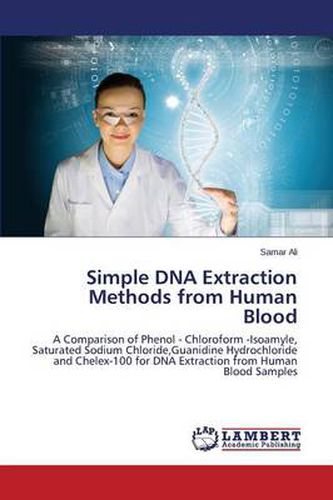Readings Newsletter
Become a Readings Member to make your shopping experience even easier.
Sign in or sign up for free!
You’re not far away from qualifying for FREE standard shipping within Australia
You’ve qualified for FREE standard shipping within Australia
The cart is loading…






This title is printed to order. This book may have been self-published. If so, we cannot guarantee the quality of the content. In the main most books will have gone through the editing process however some may not. We therefore suggest that you be aware of this before ordering this book. If in doubt check either the author or publisher’s details as we are unable to accept any returns unless they are faulty. Please contact us if you have any questions.
This study was aimed to compare between four DNA extraction methods, including phenol-chloroform-isoamyle, guanidine hydrochloride, saturated sodium chloride, and chelex-100 using 50 blood samples collected from healthy volunteers. The comparison included DNA concentration, extracted DNA purity, cost of reagents per one sample, and time consuming. After a comprehensive analysis of all factors: salt extraction gave the maximum yield of DNA, it is saver and simpler than the other methods. Moreover, this method is reliable and inexpensive. But its purity is slightly low. Phenol-chloroform-isoamyl extraction method give reliable quantity and purity of the DNA extracted. But it takes a time and labor in obtaining pure extract. Moreover, its associated toxicities warrant a judicious use. Chelex-100 resin extractions gave a DNA quantity as well as phenol-chloroform- isoamyle extraction. It is save, simple, does not require any organic solvent, and takes very short time and a little possibility of cross contamination. But it is expensive. Guanidine hydrochloride extraction is an expensive method taking a long time with a low quantity and quality of the DNA obtained.
$9.00 standard shipping within Australia
FREE standard shipping within Australia for orders over $100.00
Express & International shipping calculated at checkout
This title is printed to order. This book may have been self-published. If so, we cannot guarantee the quality of the content. In the main most books will have gone through the editing process however some may not. We therefore suggest that you be aware of this before ordering this book. If in doubt check either the author or publisher’s details as we are unable to accept any returns unless they are faulty. Please contact us if you have any questions.
This study was aimed to compare between four DNA extraction methods, including phenol-chloroform-isoamyle, guanidine hydrochloride, saturated sodium chloride, and chelex-100 using 50 blood samples collected from healthy volunteers. The comparison included DNA concentration, extracted DNA purity, cost of reagents per one sample, and time consuming. After a comprehensive analysis of all factors: salt extraction gave the maximum yield of DNA, it is saver and simpler than the other methods. Moreover, this method is reliable and inexpensive. But its purity is slightly low. Phenol-chloroform-isoamyl extraction method give reliable quantity and purity of the DNA extracted. But it takes a time and labor in obtaining pure extract. Moreover, its associated toxicities warrant a judicious use. Chelex-100 resin extractions gave a DNA quantity as well as phenol-chloroform- isoamyle extraction. It is save, simple, does not require any organic solvent, and takes very short time and a little possibility of cross contamination. But it is expensive. Guanidine hydrochloride extraction is an expensive method taking a long time with a low quantity and quality of the DNA obtained.